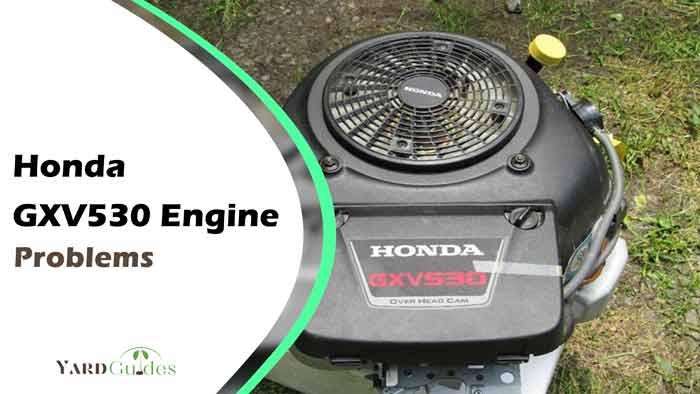The Honda GXV530 engine is a powerful and widely used engine found in various outdoor power equipment, including lawnmowers and generators. However, like any engine, it is susceptible to issues impairing its performance and lifespan.
What are the most common Honda GXV530 engine problems? The most common issues include-
- Overheating, Oil leaks
- Starting issues, Decreased engine performance, etc.
In this article, we will look at the most common problems with the Honda GXV530 engine and offer advice on how to avoid and resolve them.
Honda GXV530 Engine Problems: Our Guide To Fixing Them
Here is a table showing your Honda GXV530 Engine’s common problems with their quick solutions.
| Engine Problem | Solutions |
| Oil Leaks | 1. Replace the damaged gasket, seal, piston rings, or PCV valve. 2. If there are any loose bolts or screws, tighten them. |
| Overheating | 1. Check and replace the coolant, inspect the radiator, the thermostat, and the water pump, and replace them if damaged. 2. Top off the coolant and oil level or replace them if in bad condition. |
| Starting Issues | 1. Charge the battery. 2. Replace the damaged starter, spark plugs, wiring, and ignition switch |
| Poor Performance | 1. Clean or replace the fuel filter. Replace the damaged fuel pump and fuel lines. 2. Top off the oil level |
| Engine Stalling | 1. Clean the fuel filter and throttle body. Clean the carburetor and fuel lines. 2. Replace the damaged spark plugs and ignition coils as necessary. |
| Rough Idling | 1. Replace the spark plugs and ignition coils. Clean the fuel filter and the throttle body. 2. Check for vacuum leaks and replace damaged hoses, gaskets, or seals. |
Here are the most common problems your Honda GXV530 Engine may undergo in detail.
1. Oil Leaks
One of the most common problems with the Honda GXV530 engine is oil leaks. Oil leaks can occur for various reasons, such as damaged gaskets, seals, piston rings, the PCV valve or oil filters, or loose bolts or screws.
It could indicate an oil leak if you notice oil stains under the engine or around the oil filter.
Other symptoms of oil leaks include;
- Low oil pressure
- Decreased engine performance
- Reduced fuel efficiency
Oil leaks can damage other engine components and lead to more severe problems over time.
Solution:
To fix an oil leak, you will need to locate the source of the leak and replace any damaged parts, such as gaskets, filters, piston rings, or seals. Also, check for any loose bolts or screws and tighten them. If the problem persists, replace the PCV valve.
2. Overheating
Overheating is a dangerous problem for engines. This can occur for several reasons, including low oil or coolant levels, a damaged or clogged radiator, a faulty water pump, a clogged air filter, or a faulty thermostat.
Overheating symptoms include;
- A high-temperature gauge reading
- Steam or smoke coming from the engine
- Poor engine performance
Solution:
To resolve overheating issues, you must first identify the underlying cause and then take appropriate action.
This could include replacing the damaged radiator, water pump, or thermostat and cleaning or replacing the air filter if clogged or damaged. You should also check the oil and coolant level and add more if necessary. If the oil or coolant is in bad condition, you must replace it.
Addressing overheating issues as soon as possible is critical to avoid further engine damage.
3. Starting Issues
Starting problems can occur for several reasons, including a dead battery, a clogged air filter, a faulty carburetor, or a faulty spark plug.
Electrical system issues can also cause starting issues. They can occur due to a faulty ignition switch, damaged wiring, or a malfunctioning starter motor.
Starting problems can manifest as;
- Difficulty starting the engine
- Slow cranking
- Electrical components not working
- A clicking sound when you turn the key
Solution
- To resolve starting problems, charge the battery, clean the air filter if it is clogged, or replace it if it is damaged.
- To fix electrical system issues, replace the ignition switch if damaged, repair or replace damaged wiring, or replace the starter motor.
- You should also inspect the spark plug and replace them if faulty.
- Clean the carburetor, and if damaged, replace it.
Here is a video showing how to clean the Honda GXV530 carburetor.
4. Poor Performance
Your engine is supposed to be a reliable companion on the road. Still, when it starts to underperform, it can quickly turn into a frustrating and potentially dangerous experience.
Poor performance can be due to various issues, such as a clogged fuel filter, low oil level, damaged fuel lines, or a malfunctioning fuel pump. Some signs of poor performance include:
- Engine sputtering or stalling
- Difficulty starting
- Reduced engine performance
- Poor fuel economy
Solution:
- To fix fuel system problems, replace the fuel filter if damaged and clean it if clogged.
- Next, replace the fuel lines and fuel pump if damaged.
- You should also check the oil level and add more if necessary.
5. Engine Stalling
Nothing is more frustrating than having your engine stall unexpectedly. Whether in the middle of a project or on the way to a job site, engine stalling can cause significant delays and headaches.
Various factors, including fuel delivery issues, faulty spark plugs, bad ignition coils, clogged carburetors, or throttle body, cause this issue. Here are some engine stalling symptoms:
- Sudden stalling
- Stalling during idle
- Stalling under load
- Stalling during startup
Solution:
- Check and replace the fuel filter if damaged or clean it if dirty.
- Clean the throttle body, the carburetor, and the fuel lines.
- Replace the spark plugs and ignition coils as necessary.
- If the problem persists, replace the carburetor.
6. Rough Idling
Rough idling not only affects the overall performance of your machinery but can also lead to more severe engine issues down the line. Several factors, including faulty spark plugs, dirty throttle body, bad ignition coils, and vacuum leaks, can cause this issue.
Here are some symptoms of rough idling and their solutions:
- Engine shakes or vibrates excessively while idling
- Engine hesitates or jerks while idling
- Engine’s RPM fluctuates while idling
- Engine sounds rough or uneven while idling
Solution:
- Replace the spark plugs and ignition coils if damaged, clean the fuel filter and the throttle body.
- Also, use a vacuum gauge or smoke test to locate the source of a vacuum leak.
- Look for cracked or damaged hoses, gaskets, seals, or loose connections and replace them.
Tips To Prevent Honda GXV530 Engine Problems
Here are some maintenance tips to keep your engine in good working condition:
Regular Maintenance
Regularly scheduled maintenance, such as oil changes, spark plug replacements, and air filter replacements, help prevent common problems. Specific maintenance schedules can be found in your owner’s manual.
Inspection of Engine Parts
Regularly inspecting engine components, such as gaskets, seals, and hoses can help you identify potential problems early and prevent them from becoming more significant.
Using High-Quality Oil and Filters
Using high-quality oil and filters can help protect your engine from damage and improve its overall performance.
Proper Use and Storage of Engine
Properly using and storing your engine, such as avoiding overloading it or exposing it to extreme temperatures, can help prevent damage and extend its lifespan.
Troubleshooting Techniques
Learning how to troubleshoot common problems, such as starting or overheating, can help you quickly identify and resolve issues before they become bigger problems.
Conclusion
Honda GXV530 engine problems can affect the performance and lifespan of the engine. However, most problems can be diagnosed and solved with proper maintenance and repair.
By following the solutions provided for each problem, you can ensure that your Honda GXV530 engine runs smoothly and efficiently. Regular maintenance can also prevent these problems from occurring in the first place.
It is essential to diagnose and fix the issue as soon as possible. Ignoring engine problems can lead to more severe and expensive repairs down the line.



